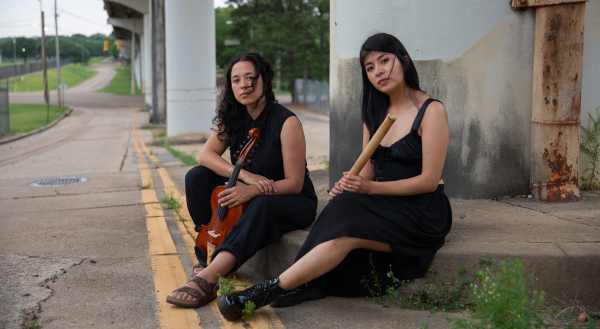

Zosha Warpeha & Mariel Terán
"Orbweaver / Tejedor de orbes" has Warpeha fast plucking the strings of her Hardanger d'amore, her playing not so much pizzicato as we know it, but a rapidly percussive finger movement with Terán adding a mixture of equally percussive and breathy flute interjections, interspersed with longer single notes.
Zosha Warpeha lives in New York and studied the Hardanger fiddle and its music in Norway. That instrument, coming uniquely from the Norwegian musical tradition, is closely related to the baroque viola d'amore, and Warpeha's instrument brings that connection closer, with an extra upper string and five underlying sympathetic strings. As with her solo album, the influence of the Norwegian tradition is evident, not so much in the way the pieces are structured - as these improvisations are more open-ended, but in the detail of her phrasing, which is very much in evidence on “Dusted Sparrow/Gorrión.”
Mariel Terán is from Bolivia and lives there in the city of La Paz, 3,600 metres above sea level. While not born into a tradition of playing Andean music she was later drawn to it as a musician and she also uses flutes from that tradition, attracted by the rich potential of sound they offer. The improvisations of the two musicians are, however, not only inspired by music from the past but also by the wider sound world found in nature, whether that be birds, insects or something else and they see parallels in the way that human creativity, like the processes of nature, arises from an inner need. Connections in the music with nature are not always overt, but the title of “Swarm/Enjambre” certainly colours the way you hear the sounds being produced.
The improvised dialogue heard on Orbweaver doesn't follow the model of improvisation found in most jazz, blues and certainly a good deal of roots music. These pieces are not variations on an established melody to be returned to, but investigative journeys, Warpeha and Terán seeking out the common ground they might share, while bringing their own background to the table. Sometimes a long bowed note of the fiddle and the same note found on a flute are almost indistinguishable played together, until the pitch of one shifts slightly. As well as the variety and richness of sounds produced here it is also these subtle nuances which draw you in, making it a quite special listening experience. “This is elemental music, physical music, music that casts off and embraces the leap into open air,” we are told in the liner notes. Sounds right to me.
Further listening:
Search RootsWorld
|